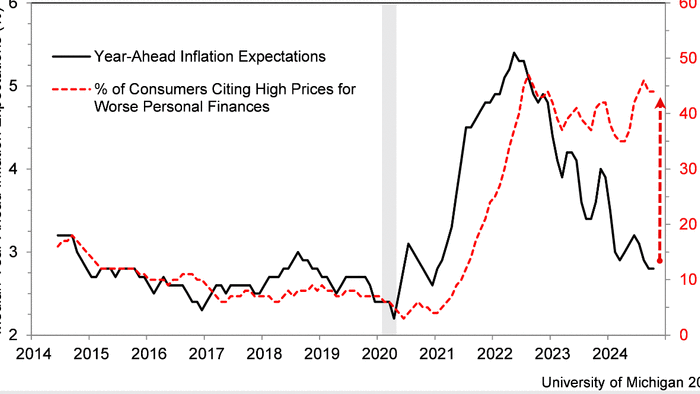In October’s preliminary data from the University of Michigan (UMich) sentiment survey, there was an upward shift in medium-term inflation expectations, with the 5-10 year projection reaching 2.9%. This increase has contributed to a decline in overall consumer sentiment, which fell from 70.1 to 68.9, notably lower than the anticipated 71.0. The report indicated that both the current conditions index and the expectations index for the future also dropped during this period. Such a significant decline in sentiment suggests that consumers are becoming increasingly uneasy about economic conditions, despite some easing in inflation expectations in recent months.
Despite a softening of inflation expectations, public concern over rising prices remains exceedingly high. The UMich survey highlights a disconnect: while people may expect inflation to decrease over the medium term, they are still grappling with the immediate impact of high prices. This paradox emphasizes the nuances of consumer behavior and sentiment, suggesting that individuals are not entirely convinced that inflation will subside soon enough to alleviate the financial strain they currently experience.
An important aspect of this sentiment reflects an understanding among consumers regarding the difference between static price levels and dynamic inflation rates. The average American appears to comprehend that while inflation metrics may signal a reduction in the rate of change, the actual cost of living — which directly affects daily expenses — remains a pressing concern. This distinction is critical, as it influences consumer behavior and spending decisions, with most being more sensitive to current pricing than future expectations of inflation.
The sentiment shifts and price concerns indicate that economic perceptions among the public can heavily influence broader market trends. Sustained anxiety about prices suggests that consumers may tighten their budgets, leading to decreased spending in various sectors. This pullback can have ripple effects throughout the economy, potentially impacting businesses reliant on consumer discretionary spending and complicating recovery efforts post-economic downturns.
Furthermore, keeping a pulse on consumer sentiment is essential for policymakers and economists, as it can serve as an early indicator of broader economic health. The apparent disconnect between inflation expectations and actual price experiences suggests that while many may project optimism for the future, immediate concerns about economic stability and purchasing power are driving present behavior. Understanding these dynamics is vital for crafting effective economic strategies and interventions aimed at alleviating consumer concerns.
In conclusion, the divergence between improving inflation expectations and persistent worries about price levels reveals the complexity of consumer sentiment. As economic players navigate this landscape, it becomes increasingly clear that addressing the fundamental issues related to costs of living will be crucial for restoring confidence and stimulating economic activity. Policymakers, businesses, and financial institutions must heed these signals to foster resilience and ensure that recovery efforts resonate with the experiences of everyday Americans.

